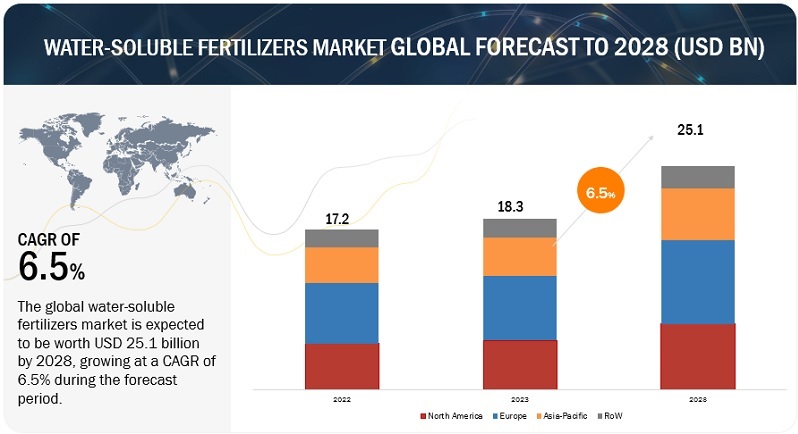The water-soluble fertilizers market size is projected to reach $25.1 billion by 2028 from $18.3 billion in 2023, growing at a CAGR of 6.5% from 2023 to 2028. The water-soluble fertilizer industry has experienced a shift in demand due to changing consumer preferences and an increasing need for convenience. Water soluble fertilizers offer an advantage over traditional fertilizers, such as their quick dissolving ability in water and a high level of nutrient availability. Companies are investing in R&D to meet the market’s needs.

Download PDF Brochure: https://www.marketsandmarkets.com/pdfdownloadNew.asp?id=1055
Major Applications of Water-soluble Fertilizers Market
The major applications of water-soluble fertilizers span across various sectors:
- Agriculture: Water-soluble fertilizers are extensively used in agriculture for fertigation, a method of applying fertilizer through irrigation systems. They are particularly beneficial for crops grown in greenhouses, hydroponic systems, or areas with poor soil quality.
- Horticulture: Water-soluble fertilizers are commonly used in horticulture for the cultivation of fruits, vegetables, ornamental plants, and flowers. They provide precise nutrient delivery, promoting healthy plant growth and higher yields.
- Greenhouse Cultivation: In greenhouse cultivation, water-soluble fertilizers are preferred due to their ability to dissolve quickly and completely in water, ensuring uniform nutrient distribution to plants grown in controlled environments.
- Foliar Feeding: Water-soluble fertilizers can be applied as foliar sprays, allowing nutrients to be absorbed directly through the leaves. This method is especially useful during periods of rapid growth or when plants exhibit nutrient deficiencies.
- Hydroponics: In hydroponic systems where plants grow without soil, water-soluble fertilizers are essential for providing nutrients directly to the plant roots suspended in nutrient-rich water. They play a crucial role in maximizing yields and maintaining crop health in hydroponic farming.
- Drip Irrigation Systems: Water-soluble fertilizers are compatible with drip irrigation systems, enabling precise nutrient delivery to crops while minimizing nutrient leaching and waste. This method is widely adopted in commercial agriculture for efficient nutrient management.
- Fruit and Vegetable Production: Water-soluble fertilizers are instrumental in fruit and vegetable production, ensuring optimal nutrient uptake by crops to support healthy growth, improve fruit quality, and enhance yields.
Water-soluble Fertilizers Market Growth Drivers
The water-soluble fertilizers market has been experiencing steady growth over the past decade due to several factors. Water-soluble fertilizers are easily soluble in water and provide essential nutrients to plants in a readily available form. This characteristic makes them highly efficient in terms of nutrient uptake by plants, leading to improved crop yields and quality.
Several key drivers are contributing to the growth of the water-soluble fertilizers market:
- Increasing Demand for High-Quality Crops: With the global population steadily rising, there is a growing demand for high-quality crops to meet food security needs. Water-soluble fertilizers enable precise nutrient management, resulting in healthier plants and better yields.
- Rising Adoption of Protected Agriculture: Protected agriculture, including greenhouse and hydroponic farming, is gaining popularity worldwide due to its ability to optimize resource use and mitigate environmental challenges. Water-soluble fertilizers are essential in these systems, as they can be easily integrated into irrigation systems, providing nutrients directly to the roots of plants.
- Growing Awareness about Sustainable Agriculture: There’s a global push towards sustainable agricultural practices to minimize environmental impact and conserve natural resources. Water-soluble fertilizers allow for precise application, reducing the risk of nutrient runoff and groundwater contamination compared to traditional granular fertilizers.
- Technological Advancements: Ongoing research and development efforts have led to the development of innovative water-soluble fertilizer formulations tailored to specific crop needs and environmental conditions. These advancements enhance nutrient uptake efficiency and minimize nutrient waste.
- Government Initiatives and Support: Many governments are encouraging the adoption of water-soluble fertilizers through subsidies, incentives, and educational programs aimed at promoting sustainable agriculture practices.
Asia Pacific provides the highest growth prospects for the water-soluble fertilizers market in 2023
Asia-Pacific is highly dependent on agriculture, with countries like India and China being agriculturally dominant. The prime factor contributing to the growth of water-soluble fertilizers in the region is the growing adoption of water-soluble fertilizers to meet the intensifying food demand and escalating population. Additionally, key players like Nutrien (Canada), Israel Chemical Company (Israel), Yara International (Norway), and others have a strong presence and market share in the region, which further boost the vitamin market in the Asia Pacific.
Water-soluble Fertilizers Companies
Key players in this industry includes Nutrien (Canada), Israel Chemical Company (Israel), Sociedad Quimicay Minera De Chile (SQM) (Chile), K+S Aktiengesellschaft (Germany), Yara International (Norway), Haifa Chemicals Ltd (Israel), Compo GmbH (Germany), Coromandel International Ltd (India), The Mosaic Company (US), Hebei Monband Water Soluble fertilizers Co., Ltd (China), Agafert (India), EuroChem (Switzerland), Azoty Group (Poland), Vakichim (Bulgaria), Gujarat State Fertilizers & Chemicals Ltd (India), IFFCO (India), SPIC (India), Aries Agro Ltd (India), Mangalore Chemicals & Fertlizers Ltd (India), Incitec (Australia).

